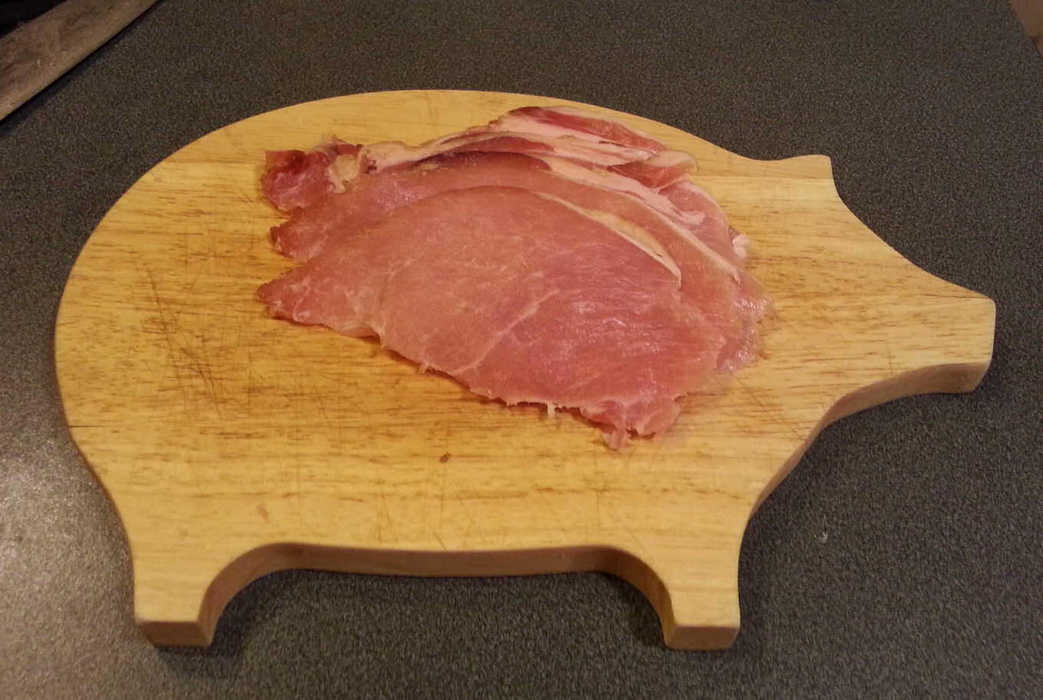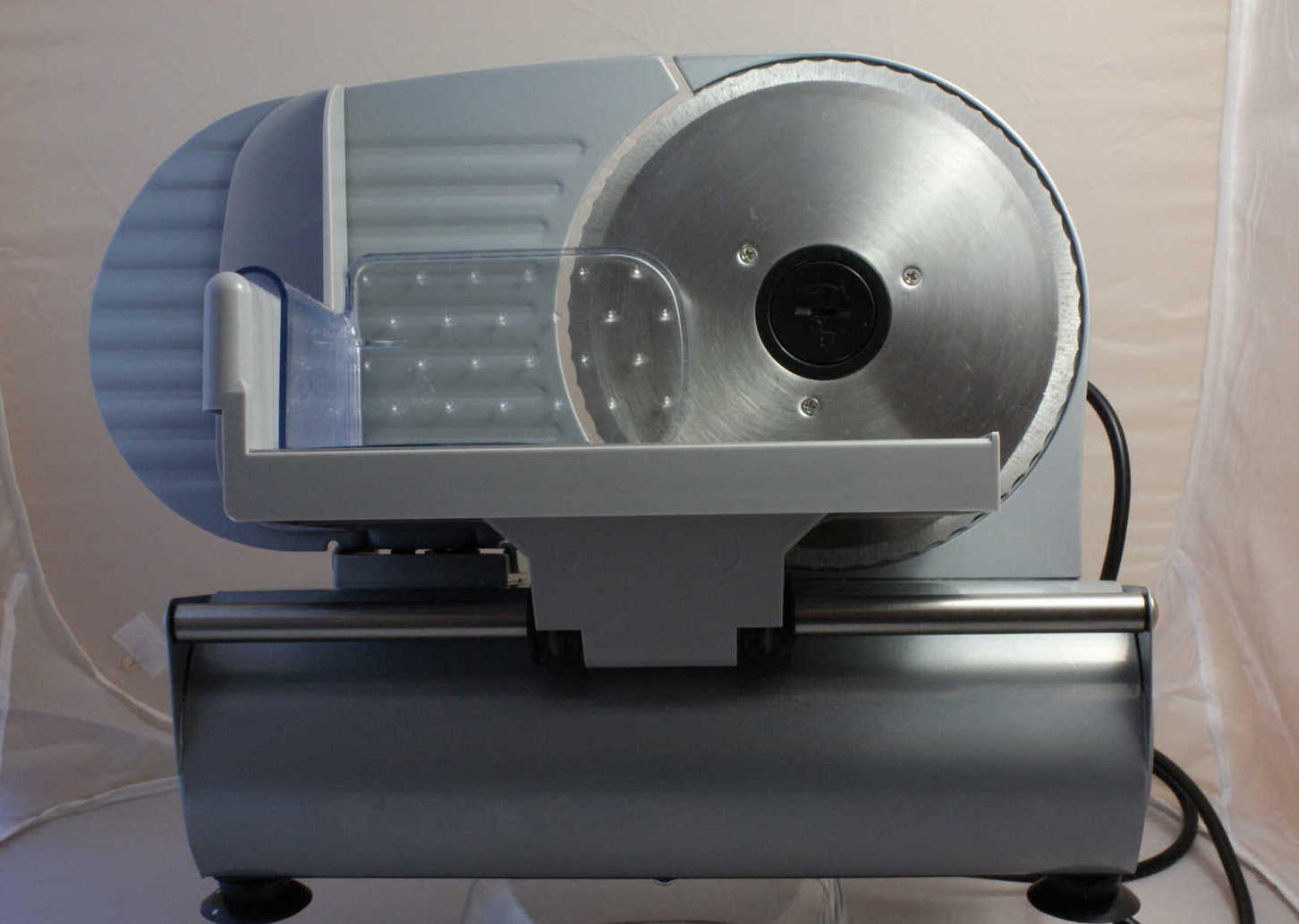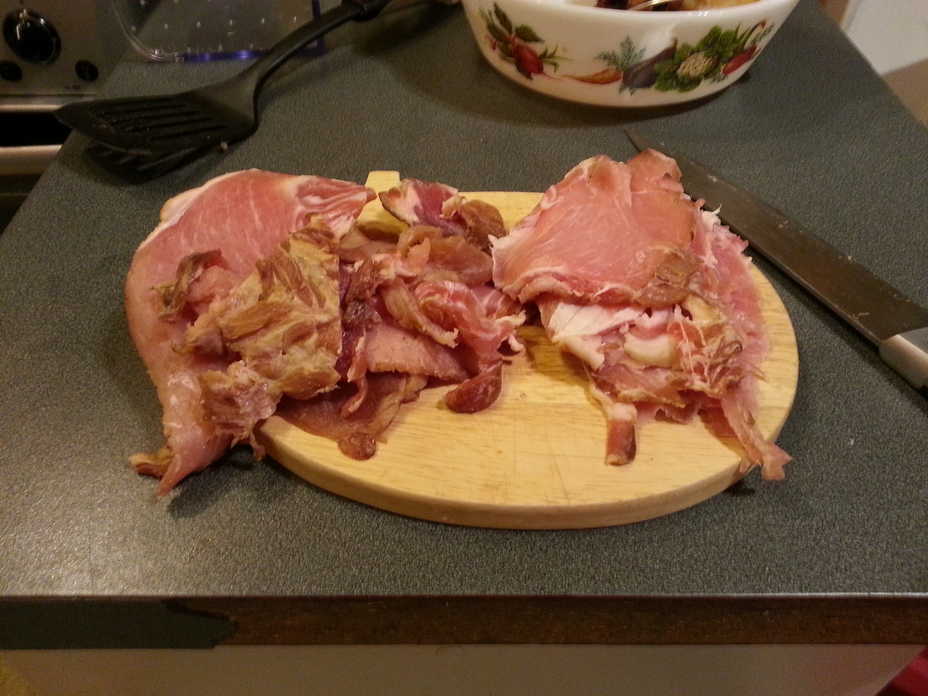
Makin' Bacon
Hmmmm bacon. Finest of the cured meats. Carnivores' ambrosia. Vegetarians' bane.
My good friend Aidan and I have been talking about curing meat for an age now, without getting our fingers out. It seemed like it would be particularly easy for him seeing as he has that nice garden shed and all, whereas I have occasional access to a vaguely cool bedroom when it's free, or a share of the dark, dank, earthy pit known as our communal garden.
Turns out that making bacon is easy as pie. The hard part is slicing the stuff up afterwards.
All you need to make your own (unsmoked, dry-cured) bacon is a choice piece of pig and a salty cure. You then rub the cure all over your pork, you leave it to penetrate, you clean it off, and you let the meat dry.
Job done.
Unfortunately getting those beautiful, even, 1mm thin bacon slices is a good bit more challenging - the only realistic way is to splash out on an electric meat slicer.
The one I bought is a comedy version sponsored by Andrew James, which has all the appearance of a professional meat slicer, but little of the functionality. In particular the disk spins at a depressingly pedestrian, and worryingly variable, pace, which results in as much torn and shredded meat as it does sliced bacon. But hey - you pays your money, you takes your choice; it all still fries.
I must admit, I bought a ready-mixed cure, but it's easy enough to mix your own. Technically everything except the salt is optional, but the saltpetre keeps the bacon pink and inhibits the growth of botulism, both beneficial things you might think. Saltpetre has had quite a bad press recently, supposedly being responsible for causing cancer or global warming or some such, but then if you paid attention to every food scare and trendy piece of nutritional advice you'd never get to eat anything.
A bit of sugar helps to offset the saltiness, though again you can skip it if you like.
Basically for each 1kg of pork you'll need roughly:
You don't need to remove the skin, if you're using belly, but I would - it will help the cure to penetrate and save you peeling the rind off the rashers afterwards. A nice 1kg piece is a good size for home-curing.
I haven't yet gotten into the whole smoking thing - this green bacon is quite delicious enough, and setting up a smoker looks pretty daunting, but I might get around to trying it. Getting the temperature right to avoid poisoning yourself looks like a bit of a challenge!
When you come to slice your hog, it's a good idea to stick it in the freezer for a while to firm it up first especially if you have a feeble domestic slicer. Just don't forget about it!
Really thin bacon is about 1/32" (0.8mm) thick, giving around 30 slices per lb. Regular bacon about 1/16" (1.5-2mm) with more like 18 slices per lb and thick slices around 1/8" (3mm) yielding maybe a dozen slices per lb.
Now you've discovered how incredibly simple it is to make, as you cook yourself some of the best damn bacon sandwiches you've ever had with your own exquisite bacon you'll find yourself marvelling at the lack of shrinkage and foamy white jizz in your frying pan.
How do those Local Fucking Supermarkets™ screw it up so badly?
My good friend Aidan and I have been talking about curing meat for an age now, without getting our fingers out. It seemed like it would be particularly easy for him seeing as he has that nice garden shed and all, whereas I have occasional access to a vaguely cool bedroom when it's free, or a share of the dark, dank, earthy pit known as our communal garden.
Turns out that making bacon is easy as pie. The hard part is slicing the stuff up afterwards.
All you need to make your own (unsmoked, dry-cured) bacon is a choice piece of pig and a salty cure. You then rub the cure all over your pork, you leave it to penetrate, you clean it off, and you let the meat dry.
Job done.
Unfortunately getting those beautiful, even, 1mm thin bacon slices is a good bit more challenging - the only realistic way is to splash out on an electric meat slicer.
The one I bought is a comedy version sponsored by Andrew James, which has all the appearance of a professional meat slicer, but little of the functionality. In particular the disk spins at a depressingly pedestrian, and worryingly variable, pace, which results in as much torn and shredded meat as it does sliced bacon. But hey - you pays your money, you takes your choice; it all still fries.
I must admit, I bought a ready-mixed cure, but it's easy enough to mix your own. Technically everything except the salt is optional, but the saltpetre keeps the bacon pink and inhibits the growth of botulism, both beneficial things you might think. Saltpetre has had quite a bad press recently, supposedly being responsible for causing cancer or global warming or some such, but then if you paid attention to every food scare and trendy piece of nutritional advice you'd never get to eat anything.
A bit of sugar helps to offset the saltiness, though again you can skip it if you like.
Basically for each 1kg of pork you'll need roughly:
- 40g of salt
- 0.3g saltpetre (potassium nitrate) optional - if you're prepared to dice with bacteria
- 4g sugar optional
Optional flavourings:- ground pepper
- ground herbs
- paprika
- 1 tbsp garlic powder
- 1 tbsp molasses
- 1 tbsp black treacle
You don't need to remove the skin, if you're using belly, but I would - it will help the cure to penetrate and save you peeling the rind off the rashers afterwards. A nice 1kg piece is a good size for home-curing.
I haven't yet gotten into the whole smoking thing - this green bacon is quite delicious enough, and setting up a smoker looks pretty daunting, but I might get around to trying it. Getting the temperature right to avoid poisoning yourself looks like a bit of a challenge!
When you come to slice your hog, it's a good idea to stick it in the freezer for a while to firm it up first especially if you have a feeble domestic slicer. Just don't forget about it!
Really thin bacon is about 1/32" (0.8mm) thick, giving around 30 slices per lb. Regular bacon about 1/16" (1.5-2mm) with more like 18 slices per lb and thick slices around 1/8" (3mm) yielding maybe a dozen slices per lb.
Now you've discovered how incredibly simple it is to make, as you cook yourself some of the best damn bacon sandwiches you've ever had with your own exquisite bacon you'll find yourself marvelling at the lack of shrinkage and foamy white jizz in your frying pan.
How do those Local Fucking Supermarkets™ screw it up so badly?
Dry-Cured Bacon
meat ingredient breakfast
I found a nice fatty piece of tenderloin which worked beautifully,
though at £20/kg it wasn't the cheapest cut.
Makes around 2½ dozen rashers
Ingredients
- 1 kg pork
- about 40g salt cure
Make, or buy your cure.
Mix with the molasses, black treacle, herbs or spices you fancy.
Rub the pork thoroughly with the cure, being sure to get all the nooks and crannies. Vacuum pack the pork or seal it in a freezer bag squeezing out as much air as possible, and put in the fridge for 6 days. Turn the bag over every day giving it a bit of a squidge to re-distribute the cure. If tons of water gets drawn out you might need to drain it off mid-cure.
After the 6 days, wash off the cure in cold water, pat the meat dry and hang it in a cool, well-ventilated place for a couple of days to dry. Use a meathook if you have one, or hang it up with string - make a hole through it or just tie it around. You can loosely wrap the bacon with muslin to keep away the critters, and it's a good idea to have a tray underneath to catch any stray drips, especially if you've used a molassess cure.
You can hang the bacon like this for as long as you like; at least a day and up to a couple of weeks. It will likely develop a powdery white pellicle or mould - which is quite normal. You can wipe this off with a vinegar-soaked cloth if it offends you, but it's actually forming a nice protective layer over the fat.
Once dried even this green bacon should keep for two or three months as long as the temperature and humidity are kept low.
Mix with the molasses, black treacle, herbs or spices you fancy.
Rub the pork thoroughly with the cure, being sure to get all the nooks and crannies. Vacuum pack the pork or seal it in a freezer bag squeezing out as much air as possible, and put in the fridge for 6 days. Turn the bag over every day giving it a bit of a squidge to re-distribute the cure. If tons of water gets drawn out you might need to drain it off mid-cure.
After the 6 days, wash off the cure in cold water, pat the meat dry and hang it in a cool, well-ventilated place for a couple of days to dry. Use a meathook if you have one, or hang it up with string - make a hole through it or just tie it around. You can loosely wrap the bacon with muslin to keep away the critters, and it's a good idea to have a tray underneath to catch any stray drips, especially if you've used a molassess cure.
You can hang the bacon like this for as long as you like; at least a day and up to a couple of weeks. It will likely develop a powdery white pellicle or mould - which is quite normal. You can wipe this off with a vinegar-soaked cloth if it offends you, but it's actually forming a nice protective layer over the fat.
Once dried even this green bacon should keep for two or three months as long as the temperature and humidity are kept low.


I used the usual amount of salt cure, for the usual amount of time (in fact 7 days - one day extra) and it just still smelled porky (and increasingly high), if you know what I mean, rather than cured. We took no chances and ate it first over the next seasonal week to no ill effects, but still. The other two (slightly differently) cured hunks were just fine.
Go figure.